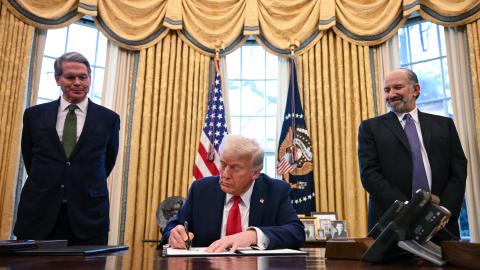Two major shifts in military strategy allowed the United States to win the Cold War with the Soviet Union. One was the Strategic Defense Initiative launched by President Ronald Reagan in 1983. It convinced Soviet leader Mikhail Gorbachev that the U.S.S.R. couldn’t compete in a high-tech weapons race without major economic and political changes—changes that ultimately backfired and led to the Soviet Union’s collapse.
The other shift, less heralded, was Sea Plan 2000, a bold new idea for reviving American sea power in the face of a Soviet bid for naval supremacy. Reagan would be the president to put the plan in motion, and his secretary of the Navy, John Lehman, would be the man to implement it. As Mr. Lehman tells us in “Oceans Ventured,” the strategy was first conceived in Newport, R.I., roughly three years before Reagan’s election—at a June 1977 dinner with Mr. Lehman, Graham Claytor (the Navy secretary), James Woolsey (counsel to the Senate Armed Services Committee) and the military-affairs author Bing West. Mr. West served as amanuensis, recording the gist of the plan on a napkin. Over time, it grew into a full-blown proposal and led, not long after, to the rebirth of the U.S. Navy’s global dominance, often summed up as “the 600-ship Navy.”
In fact, as Navy secretary Mr. Lehman never quite made it to 600 ships—594 was as far as he got. The ships that the Navy did build, however, included a new generation of warships like Aegis cruisers and destroyers with advanced antimissile systems, and Ohio-class nuclear submarines of the sort that the novelist Tom Clancy would make famous in “The Hunt for Red October” (1984). There was as well an increase in the number of Nimitz-class aircraft carriers.
Even more important than the ships was a change in how the Navy planned to use them. Mr. Lehman’s “Command of the Seas” (1988) detailed the arduous process of expanding the Navy despite congressional opposition and a cumbersome Pentagon acquisition system. “Oceans Ventured” describes the men and events that enabled the Navy to snatch the strategic initiative from a Soviet navy determined to challenge the U.S. around the globe.
The Carter administration’s response to the Soviet challenge was to go into a defensive crouch and deploy the Navy’s dwindling assets, after years of budget cuts, to protect the Mediterranean and Atlantic approaches. Sea Plan 2000, from its conception, proposed instead an aggressive strategy. It was based, as Mr. Lehman relates, on recent naval war games in which “the Red Team [Soviets] had no credible counter to a Blue offensive”—even in places where the Blue Team was outnumbered or outclassed.
When Reagan’s election gave Sea Plan 2000 a chance to become reality, Mr. Lehman found that he had valuable helpers inside the Navy. One was Adm. Thomas Hayward, chief of Naval Operations from 1978 to 1982 and the former commander of the Seventh Fleet in the Pacific. Adm. Hayward had decided early on that the Navy’s biggest problem was a lack of strategic thought. In his mind, numerical inferiority had made it all the more imperative not to cede the initiative to the Soviets or to focus on the Atlantic at the expense of the Pacific and Indian oceans. Through a changed U.S. approach, he theorized, the Soviets could be made to grasp that, in the event of war, their most valuable naval asset, their burgeoning fleet of ballistic-missile submarines, would be vulnerable to attack. Only then would they rethink their entire naval strategy.
Adm. Hayward and his team got a chance to advance their theory with Ocean Venture, a massive naval exercise in 1981 involving more than 250 ships and 1,000 aircraft from 14 countries. The goal was to demonstrate to Soviet watchers that the U.S. and its allies could secure their own sea lines of communication amid the Soviet submarine threat and also bring the war home to the Soviet Union. Ocean Venture’s commanding officer, Adm. James “Ace” Lyons, was, Mr. Lehman says, as focused on achieving the operation’s “effect on the global balance of power between the West and the Soviet bloc” as he was on “testing his men and their equipment.”
Around the same time, Mr. Lehman notes, the U.S. fleet participated “in a sophisticated program of coordinated, calculated, forward aggressive exercises—all around the world.” The Soviets would thereby see that, with any aggressive move they made, “the might of the U.S. Navy would be off their coasts in a heartbeat.”
In his effort to rebuild the Navy, Mr. Lehman had two inadvertent allies. One was the actor Tom Cruise, whose 1986 movie “Top Gun” gave naval aviation a new glamour. The other was Tom Clancy, whose novel about a “lost” Soviet submarine raised the public’s awareness of the Cold War at sea. By the end of the decade it was the Soviet navy—confronted by a new strategy, new ships and new advanced weaponry—that found itself in a defensive crouch. The collapse of the U.S.S.R. in 1991 merely finished the job that Mr. Lehman and his colleagues had started, making the U.S. the world’s naval superpower once again.
If the Soviet Union was challenging American naval dominance back then, Mr. Lehman observes, China is doing so today. Could we build a 600-ship Navy now? With far fewer active shipyards than in 1980, and a Pentagon acquisition process even more convoluted than before, getting to the 355 ships that President Donald Trump has made a priority would seem a miracle. “Oceans Ventured,” in its engrossing and illuminating narrative, reminds us that numbers are less important than strategy. Let’s hope a new generation of thinkers will soon gather to determine how best to respond to China’s rising challenge. Who knows? Maybe they’ve gathered already, and their plan is recorded on someone’s napkin.

















